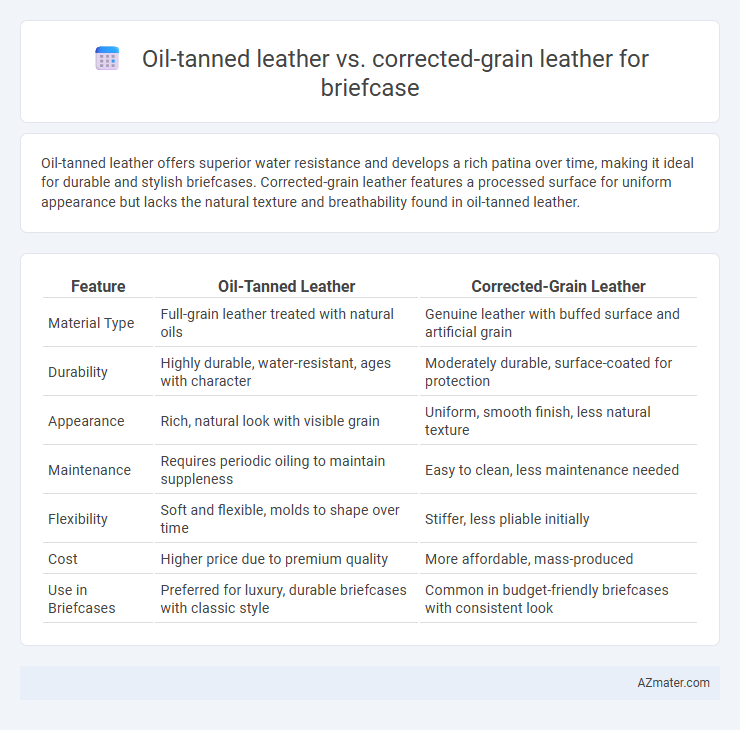Oil-tanned leather offers superior water resistance and develops a rich patina over time, making it ideal for durable and stylish briefcases. Corrected-grain leather features a processed surface for uniform appearance but lacks the natural texture and breathability found in oil-tanned leather.
Table of Comparison
| Feature | Oil-Tanned Leather | Corrected-Grain Leather |
|---|---|---|
| Material Type | Full-grain leather treated with natural oils | Genuine leather with buffed surface and artificial grain |
| Durability | Highly durable, water-resistant, ages with character | Moderately durable, surface-coated for protection |
| Appearance | Rich, natural look with visible grain | Uniform, smooth finish, less natural texture |
| Maintenance | Requires periodic oiling to maintain suppleness | Easy to clean, less maintenance needed |
| Flexibility | Soft and flexible, molds to shape over time | Stiffer, less pliable initially |
| Cost | Higher price due to premium quality | More affordable, mass-produced |
| Use in Briefcases | Preferred for luxury, durable briefcases with classic style | Common in budget-friendly briefcases with consistent look |
Introduction to Leather Types for Briefcases
Oil-tanned leather offers a rich, natural finish with enhanced durability and water resistance, making it ideal for rugged, long-lasting briefcases. Corrected-grain leather features a smooth, uniform surface with embossed patterns to mask imperfections, providing a polished and affordable option for professional-looking briefcases. Both types balance style and function, catering to different preferences in durability and appearance for everyday business use.
What is Oil-Tanned Leather?
Oil-tanned leather is treated with natural oils and waxes during the tanning process, resulting in a durable, water-resistant, and flexible material ideal for briefcases. This leather type develops a rich patina over time, enhancing its appearance and character with use. Compared to corrected-grain leather, oil-tanned leather maintains its natural surface texture without artificial coatings, making it more breathable and resistant to cracking.
What is Corrected-Grain Leather?
Corrected-grain leather is a type of leather that has been sanded and buffed to remove surface imperfections, then coated with an artificial grain layer for a uniform appearance. This treatment enhances durability and stain resistance, making it a practical choice for briefcases that endure daily wear. Unlike oil-tanned leather, which retains a natural look and develops character over time, corrected-grain leather offers a more polished, consistent finish suitable for professional settings.
Visual and Textural Differences
Oil-tanned leather exhibits a rich, glossy finish with natural imperfections, offering a rugged yet luxurious aesthetic that deepens with age and use. Corrected-grain leather features a uniformly smooth surface with an artificial grain pattern, designed to hide blemishes and provide a consistent appearance but often lacks the depth and character of oil-tanned leather. The texture of oil-tanned leather feels supple and slightly oily to the touch, while corrected-grain leather feels stiffer and more polished due to its surface coating.
Durability and Longevity Comparison
Oil-tanned leather offers superior durability and water resistance due to its natural oils, making it ideal for briefcases exposed to frequent wear and varying weather conditions. Corrected-grain leather undergoes surface sanding and artificial grain application, enhancing uniformity but reducing its breathability and susceptibility to cracking over time. While oil-tanned leather develops a rich patina with prolonged use, corrected-grain leather maintains a consistent appearance but typically has a shorter lifespan under heavy daily use.
Water and Stain Resistance
Oil-tanned leather exhibits superior water and stain resistance due to its dense, oily finish that repels moisture and resists marks, making it ideal for briefcases exposed to harsh conditions. In contrast, corrected-grain leather, which undergoes sanding and coating to cover imperfections, offers moderate resistance but tends to absorb water more readily, requiring additional protective treatments to maintain durability. For long-lasting protection, oil-tanned leather briefcases provide enhanced waterproof properties and stain repellency directly from the tanning process.
Maintenance and Care Requirements
Oil-tanned leather requires regular conditioning to maintain its water-resistant properties and prevent drying or cracking, while corrected-grain leather demands less frequent conditioning due to its protective surface treatment. Cleaning oil-tanned leather involves gentle wiping with a damp cloth and specialized leather cleaners, whereas corrected-grain leather can be cleaned more easily with mild soap and water without affecting its finish. Both types benefit from proper storage away from direct sunlight and heat to preserve their durability and appearance over time.
Aging and Patina Development
Oil-tanned leather develops a rich patina over time, enhancing its character and durability through natural oils that protect and soften the material as it ages. Corrected-grain leather undergoes surface treatments that often inhibit natural aging, resulting in a less pronounced patina and a more uniform appearance without significant texture changes. For briefcases, oil-tanned leather offers a more authentic, evolving aesthetic, while corrected-grain leather maintains consistent looks with increased resistance to wear and visible imperfections.
Price and Value Considerations
Oil-tanned leather for briefcases typically commands a higher price due to its durability, rich texture, and natural water resistance, offering excellent long-term value despite the initial investment. Corrected-grain leather is more affordable but undergoes heavy sanding and coating to mask imperfections, which can reduce breathability and aging character, resulting in lower durability and potentially higher replacement costs. Choosing oil-tanned leather provides superior longevity and aesthetic appeal, making it a cost-effective option for quality-conscious buyers.
Which Leather is Best for Your Briefcase?
Oil-tanned leather offers superior durability, water resistance, and a rich, natural patina that improves with age, making it ideal for briefcases exposed to daily wear and varying weather conditions. Corrected-grain leather, treated to remove imperfections and often coated with a protective finish, provides a more uniform appearance but may lack the breathability and character of oil-tanned leather. For a briefcase that balances ruggedness and develops unique character over time, oil-tanned leather is often the best choice, while corrected-grain leather suits those prioritizing a consistent, polished look.

Infographic: Oil-tanned leather vs Corrected-grain leather for Briefcase
 azmater.com
azmater.com